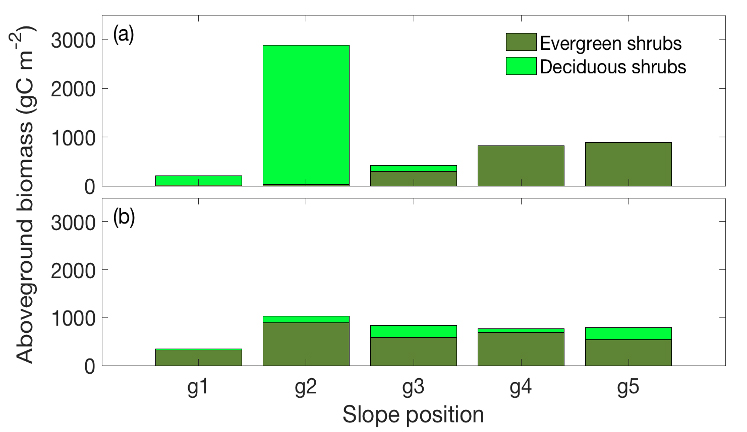February 26, 2021
Topographical Controls on Hillslope-Scale Hydrology Drive Shrub Distributions on the Seward Peninsula, Alaska
Topography and landscape hydrology are key environmental controls on shrub expansion.

Modeled shrub biomass across the five Kougarok Hillslope transect gridcells for (a) the coupled transect mode (allow lateral interconnection) and (b) without lateral interconnection.
[Reprinted with permission from Mekonnen, Z. A., W. J. Riley, R. F. Grant, et al. “Topographical Controls on Hillslope-Scale Hydrology Drive Shrub Distributions on the Seward Peninsula, Alaska,” Journal of Geophysical Research: Biogeosciences, 126(2). e2020JG005823. (2021) [DOI: 10.1029/2020JG005823]. © 2021 American Geophysical Union.]
The Science
Researchers examined how topography affects shrub expansion by analyzing site observations, multi-decadal remote sensing, and a three-dimensional ecosystem model (ecosys) at the Kougarok site on the Seward Peninsula, Alaska. The team found that topographic controls on lateral fluxes of water, nutrients, and energy strongly affect shrub productivity and explain observed changes in tundra shrub cover.
The Impact
Most observations indicate that tundra shrubs are expanding mainly on hillslopes, although the controlling processes remain unclear. This study found that ignoring topographically driven drainage led to substantially underestimated shrub growth, compared to observations. This finding is important because more than a third of Arctic landscapes are classified as hills and mountains, and current land models (i.e., ELM) do not represent these spatially explicit processes.
Summary
Observations indicate shrubs are expanding across the Arctic tundra, mainly on hillslopes and primarily in response to climate warming. However, the impact topography exerts on hydrology, nutrient dynamics, and plant growth can make untangling the mechanisms behind shrub expansion difficult. Modeled biomass of the dominant plant functional types agreed very well with field measurements (R2=0.89) and accurately represented shrub expansion over the past 30 years inferred from satellite observations. In the well-drained crest position, canopy water potential and plant nitrogen (N) uptake was modeled to be low from plant and microbial water stress. Intermediate soil water content in the mid-slope position enhanced mineralization and plant N uptake, increasing shrub biomass. The deciduous shrub growth in the mid-slope position was further enhanced by symbiotic N2 fixation primed by increased root carbon allocation. The gentle slope in the poorly-drained lower-slope position resulted in saturated soil conditions that reduced soil O2 concentrations, leading to lower root O2 uptake and thereby lower nutrient uptake and plant biomass. A simulation that removed topographical inter-connectivity between gridcells resulted in (1) a 28% underestimate of mean shrub biomass and (2) over- or under-estimated shrub productivity at the various hillslope positions. Results indicate that land models need to account for hillslope-scale coupled surface and subsurface hydrology to accurately predict current plant distributions and future trajectories in Arctic ecosystems.
Principal Investigator
WIlliam Riley
Lawrence Berkeley National Laboratory
wjriley@lbl.gov
Program Manager
Daniel Stover
U.S. Department of Energy, Biological and Environmental Research (SC-33)
Environmental System Science
daniel.stover@science.doe.gov
Funding
This research was supported by the Office of Biological and Environmental Research within the U.S. Department of Energy Office of Science under contract no. DE-AC02- 05CH11231 to Lawrence Berkeley National Laboratory as part of the Next-Generation Ecosystem Experiments—Arctic (NGEE-Arctic) project.
References
Mekonnen, Z. A., W. J. Riley, R. F. Grant, et al. "Topographical Controls on Hillslope-Scale Hydrology Drive Shrub Distributions on the Seward Peninsula, Alaska." Journal of Geophysical Research: Biogeosciences 126 (2), e2020JG005823 (2021). https://doi.org/10.1029/2020JG005823.

